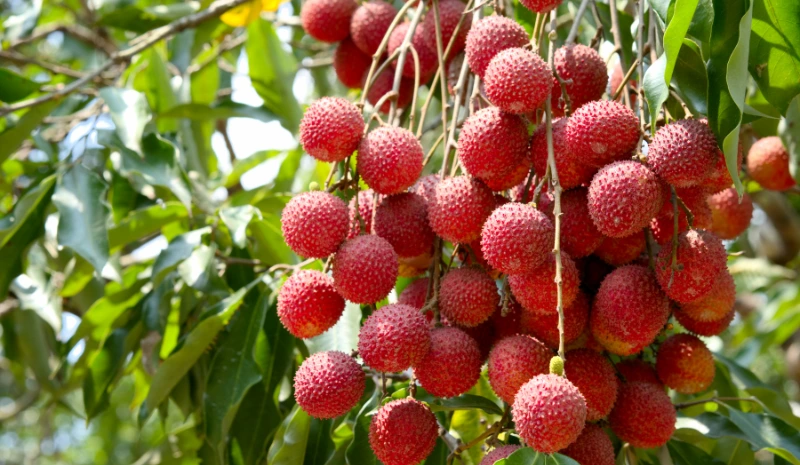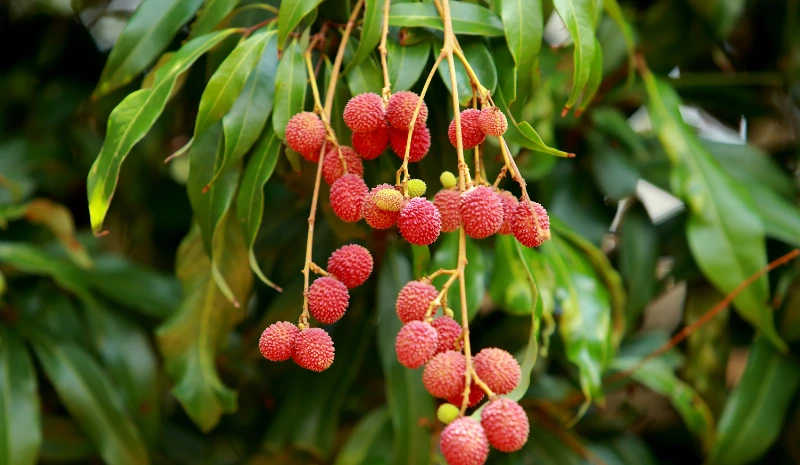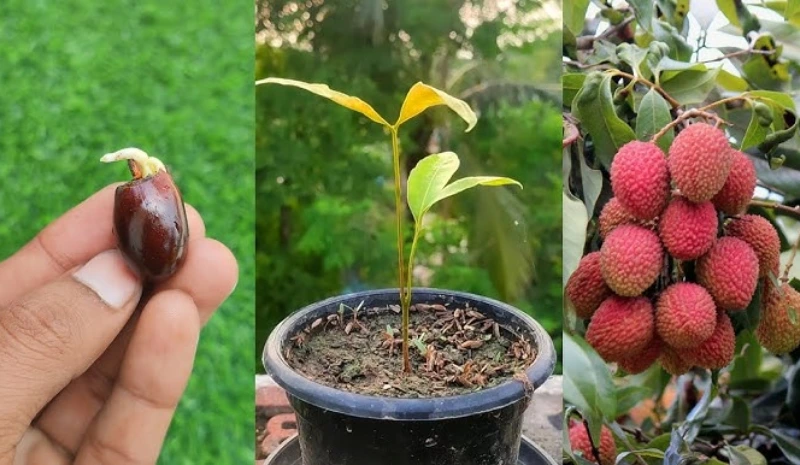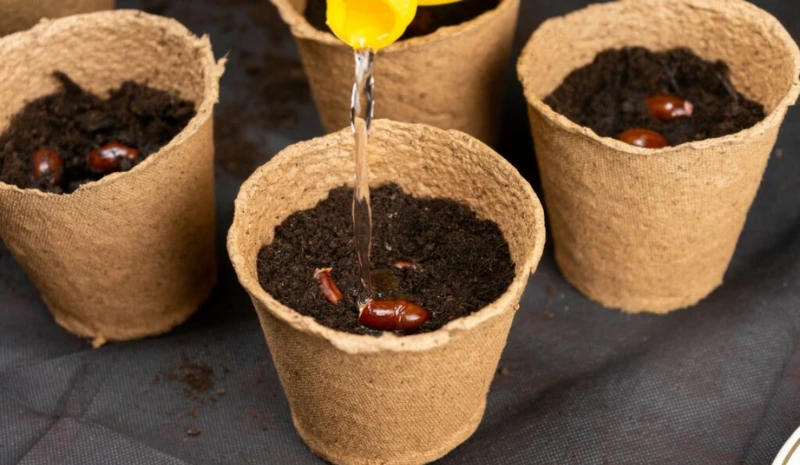Have you ever dreamed of picking fresh, juicy lychee fruits from your backyard? If you live in a warm climate and have the patience to nurture a tree, growing a lychee tree can be a rewarding experience. But let’s be honest—many gardeners struggle with getting their lychee tree to grow, bloom, and bear fruit. If you’ve tried growing one before but failed, or if you’re just starting out, this guide is for you.
What is Lychee tree?

Lychee trees (Litchi chinensis) are not just beautiful; they produce incredibly sweet and aromatic fruit. Lychee trees are a tropical delight! Native to China, these broadleaf evergreens thrive in warm, humid climates, making them ideal for states like Florida, California, and Texas and are loved not just for their delicious fruit but also for their beauty in the landscape. While commercial growers focus on the fruit, home gardeners often enjoy lychee as a gorgeous shade tree that brings a tropical vibe to any yard. And the fruit? Pure magic! Beneath its rough, red skin, you’ll find juicy, white flesh bursting with a sweet, floral flavor—like a mix of watermelon and pear with a hint of sunshine.
Here’s why you should consider growing a lychee tree:
-
Delicious fruit: Lychee fruits have a unique floral sweetness that is loved worldwide.
-
Ornamental value: With their lush green foliage and red fruit clusters, lychee trees make a stunning addition to any garden.
-
Longevity: Lychee trees can live for decades and continue to produce fruit for generations.
-
Health benefits: Rich in vitamin C, antioxidants, and fiber, lychees are a nutritious treat.
Key Features
- Scientific Name: Litchi chinensis
- Mature Size: 20–40 feet tall, 20–30 feet wide (can be pruned to maintain a smaller size)
- Cold Tolerance: Best suited for USDA Zones 9–11. Sensitive to frost but can survive brief cold snaps if protected.
- Expected Planting Period: Spring, once the soil has warmed up and the risk of frost has passed.
- Growth Rate: Moderate; typically takes 3–5 years to start producing fruit, but grafted trees may bear sooner.
- Flower Characteristics: Blooms in late winter to early spring with small, fragrant, yellow-green flowers that attract pollinators. Clusters of red, rough-textured fruit ripen in summer.
- Invasiveness: Non-invasive, but seedlings may sprout beneath mature trees if fallen fruit is left on the ground.
- Growth Habit: An evergreen tree with a dense, rounded canopy, providing shade and tropical beauty. Prefers warm, humid climates and well-draining soil. Ideal for backyard orchards and home fruit production.
Best Growing Conditions for Lychee Trees

Before planting your lychee tree, it’s essential to create the right environment to ensure healthy growth and bountiful fruit production. Here’s what you need to know:
1. Climate and Temperature
Lychee trees are true tropical plants, thriving in warm, humid climates with temperatures between 70°F to 85°F (21°C to 29°C). They love a long, hot summer but need a slight drop in temperature in the winter to encourage flowering. However, they are not frost-hardy—anything below 32°F (0°C) can severely damage or even kill the tree.
If you live in a colder region, don’t worry! Lychee trees can be successfully grown in large containers. This way, you can move them indoors or to a greenhouse during winter. Just be sure they still get plenty of light and humidity while inside.
2. Sunlight Requirements
The more sun, the better! Lychee trees need at least 6 to 8 hours of direct sunlight daily to grow strong and produce plenty of fruit. Without enough light, your tree may grow slowly and struggle to bloom.
When choosing a planting spot, go for a sheltered, sunny location—avoid areas with strong winds, as lychee trees have shallow roots and brittle branches that can be damaged easily.
3. Soil Conditions
Lychee trees are a bit picky when it comes to soil. They prefer well-draining soil that is slightly acidic to neutral (pH 5.0-7.0). Heavy clay or waterlogged soil can cause root rot, so if your soil tends to retain water, consider improving drainage by adding organic matter like compost, sand, or perlite.
If your soil is too alkaline, you can lower the pH by incorporating peat moss, sulfur, or pine needles. Mulching with organic materials like wood chips or aged compost will also help keep moisture levels stable and improve overall soil health.
4. Watering Needs
Lychee trees need consistent moisture, especially when they’re young and establishing their roots. However, overwatering is a common mistake—these trees are sensitive to waterlogged soil, which can lead to root rot.
For young trees, keep the soil evenly moist, but not soggy. Once mature, lychee trees become more drought-tolerant and only need a deep watering once a week, depending on the weather. During hot, dry spells, increase watering to prevent stress, especially when the tree is flowering or fruiting.
A good trick? Use mulch! A 2-3 inch layer of mulch around the base will help retain moisture, regulate soil temperature, and keep weeds at bay. Just be sure to keep mulch a few inches away from the trunk to prevent rot.
How to Plant a Lychee Tree

1. Choose the Right Variety
Picking the right lychee variety is the first step to success! Some types grow better in certain climates, while others are prized for their flavor or fruiting speed. Here are three of the best choices for home gardeners:
-
Brewster – A widely grown variety with juicy, sweet fruit and a deep red rind. Prefers humid conditions and is one of the most cold-tolerant varieties.
-
Mauritius – A fast-growing, heavy producer with slightly tangy, crisp fruit. This is one of the most common lychee varieties available.
-
Sweetheart – True to its name, this variety is incredibly sweet and often has a small or even seedless center, giving you more fruit to enjoy.
2. Step-by-Step Planting Guide
While it’s possible to grow a lychee tree from seed, patience is key! Seed-grown lychee trees can take up to 10 years to bear fruit, and the fruit quality may not match that of the parent tree.
For faster results, it’s best to plant a grafted or air-layered tree. These trees typically begin fruiting within 3 to 5 years and will produce fruit identical to the parent tree. If you want to enjoy homegrown lychees sooner rather than later, go with a grafted tree!
For Ground Planting
-
Choose the right location – Find a sunny, sheltered spot with at least 6-8 hours of direct sunlight daily. Avoid areas prone to strong winds, as lychee trees have shallow roots and brittle branches.
-
Prepare the soil – Lychee trees prefer well-draining, slightly acidic soil (pH 5.0-7.0). If your soil is heavy clay or alkaline, mix in organic compost, peat moss, or sand to improve drainage and lower the pH.
-
Dig a proper hole – Make the planting hole twice as wide and just as deep as the root ball to allow the roots to spread easily.
-
Plant the tree – Gently place the tree in the hole, making sure the root collar (where the trunk meets the roots) is level with the soil surface. Backfill with soil, pressing it down lightly to remove air pockets.
-
Water deeply – Give your tree a good soak after planting to help settle the soil.
-
Mulch for moisture – Apply a 2-3 inch layer of mulch (like wood chips or straw) around the base, keeping it a few inches away from the trunk to prevent rot.
For Container Growing
If you’re in a cooler climate or have limited space, lychee trees can thrive in large containers. Here’s how:
-
Pick the right pot – Use a large, deep container (at least 10-15 gallons) with drainage holes to prevent root rot.
-
Use quality soil – A well-draining potting mix with organic matter (such as peat moss or compost) is ideal. Avoid heavy garden soil, which can become compacted.
-
Plant carefully – Follow the same planting steps as ground planting, ensuring the tree sits at the correct depth.
-
Water regularly – Potted lychee trees dry out faster than those in the ground, so keep the soil evenly moist but not soggy.
-
Repot as needed – As the tree grows, you may need to move it to a larger container every few years to prevent root binding.
3. How to Grow Lychee from Seed

If you’re growing lychee at home, starting from seed is a fun and rewarding process—just be prepared for a bit of patience! Follow these steps to give your lychee seeds the best chance of sprouting:
- Soak the seeds in water for three days to help soften the outer shell and speed up germination.
- Prepare a 12-inch tall pot with well-draining potting soil—lychee seeds need plenty of space to develop strong roots.
- Plant the seeds about 1 inch deep, covering them lightly with soil.
- Keep the soil consistently moist (but not soggy) and place the pot in a warm location—lychee seeds love heat!
- Be patient! Sprouting can take anywhere from one to two weeks, depending on temperature and conditions.
- Once the seedlings appear, gradually move them to a sunnier spot after a few weeks to encourage strong, healthy growth.
Just a heads-up: lychee trees grown from seed can take 10+ years to bear fruit, and there’s no guarantee they’ll produce the same quality as the parent tree. If you’re looking for faster fruiting, consider a grafted or air-layered tree instead!
How to Care for a Lychee Tree
Caring for a lychee tree is all about providing the right nutrients, maintaining a healthy structure, and keeping pests at bay. With a little attention, your tree will reward you with lush foliage and delicious fruit for years to come! Read more: Caring for Lychee Trees in Spring: What You Need to Know for Healthy Growth
1. Fertilizing
Lychee trees benefit from regular feeding to support both growth and fruit production. When young, they thrive with a balanced fertilizer (10-10-10) every 2-3 months to establish strong roots and branches. Once mature, switch to a fertilizer higher in potassium and phosphorus to encourage flowering and fruiting. If you prefer organic options, compost, fish emulsion, and bone meal are excellent choices to promote steady, healthy development.
2. Pruning
Pruning is essential to keeping your lychee tree in shape. A light pruning every year helps remove dead or crossing branches, which improves airflow and prevents disease. Keeping an open canopy ensures sunlight reaches all parts of the tree, leading to better fruit production. However, avoid heavy pruning, as lychee trees bear fruit on the previous year’s growth—so cutting too much could mean fewer lychees next season!
3. Pest and Disease Control
Like all fruit trees, lychees can encounter pests and diseases. One of the most common problems is the Lychee Erinose Mite, which causes distorted, rough-textured leaves. A regular application of neem oil can help keep it under control. Root rot is another concern, usually caused by overwatering or poor drainage—so always plant in well-draining soil and avoid letting the roots sit in water. If you notice tiny holes in your fruit, the fruit borer may be the culprit. Protecting ripening lychees with fine netting can help keep these pests out while still allowing airflow.
How to Get Your Lychee Tree to Bear Fruit
So, your lychee tree is growing beautifully, but there’s just one problem—it won’t fruit! Don’t worry, this is a common issue, and with a few adjustments, you can encourage your tree to start producing those delicious, juicy lychees.
One of the most important tricks is to reduce watering in winter. Lychee trees naturally go through a dry period before flowering, so cutting back on irrigation can signal the tree that it’s time to bloom. Another key factor is full sun exposure—the more sunlight your tree gets, the better the chances of abundant fruit production. If your tree is shaded, consider transplanting it to a sunnier spot or trimming nearby trees to let in more light.
Fertilization also plays a big role. While young lychee trees need balanced nutrients for growth, a mature tree that isn’t flowering may benefit from a high-potassium fertilizer (such as 0-0-50 or an organic option like kelp meal). This shift in nutrients helps stimulate blooming, which leads to fruit.
Interestingly, cold stress can also help trigger flowering. Lychee trees respond well to a brief period of cool temperatures (above freezing, ideally between 40-50°F or 4-10°C) in the winter. If you’re in a warm climate where temperatures stay consistently high, your tree may struggle to enter this natural flowering phase. In that case, cutting back on watering even more during winter can mimic a “stress period” and encourage blooms.
Read more: Why Your Lychee Tree Isn’t Flowering—And How to Fix It
Harvesting Lychee Fruit

Patience pays off! Once your tree starts fruiting, you can expect lychees to ripen in early to mid-summer. The best way to tell if they’re ready? Look for fruit that is fully red, firm, and slightly bumpy—unripe lychees are often greenish or pink and will lack that signature sweetness.
When harvesting, it’s best to cut the entire fruit cluster instead of picking individual lychees. This not only makes harvesting easier but also helps protect the delicate skin of the fruit. Plus, keeping the stems attached can extend freshness.
Storage Tip:
Fresh lychees are best enjoyed immediately, but if you have extras, you can store them in the refrigerator for up to two weeks. For long-term storage, lychees can be frozen with the skin on—simply thaw when ready to eat, and the fruit inside will still be juicy and delicious!
Frequently Asked Questions
1. Can I grow a lychee tree indoors?
Yes, but it’s tricky. Lychee trees need lots of sunlight (a bright south-facing window or grow lights), high humidity, and a large pot for their expanding root system. However, even with ideal conditions, indoor trees often struggle to produce fruit, so growing them outdoors or in a greenhouse is preferred.
2. How fast does a lychee tree grow?
Lychee trees are slow growers—it can take 5+ years to reach maturity and start fruiting. If you’re starting from seed, expect an even longer wait. Grafted or air-layered trees are a better choice for quicker results.
3. Why is my lychee tree dropping leaves?
Leaf drop can be caused by overwatering, poor drainage, sudden temperature changes, or transplant shock. If the leaves are turning yellow before falling off, check for soggy soil—too much moisture can lead to root rot. If the tree has recently been moved, give it time to adjust.
4. Can I grow lychee in cold climates?
Lychee trees are not frost-hardy, so they struggle in freezing temperatures. If you live in a cold region, your best bet is to grow lychee in a container and bring it indoors during winter. Just be sure to provide warmth, humidity, and ample sunlight to keep it healthy.
Final Thoughts
Growing a lychee tree takes patience, care, and the right conditions, but the reward is absolutely worth it! Whether you’re just starting out or fine-tuning your tree’s growth, these tips will help you enjoy sweet, homegrown lychees for years to come.
Have any questions or personal experiences with growing lychee trees? Drop a comment below—I’d love to hear from you!
